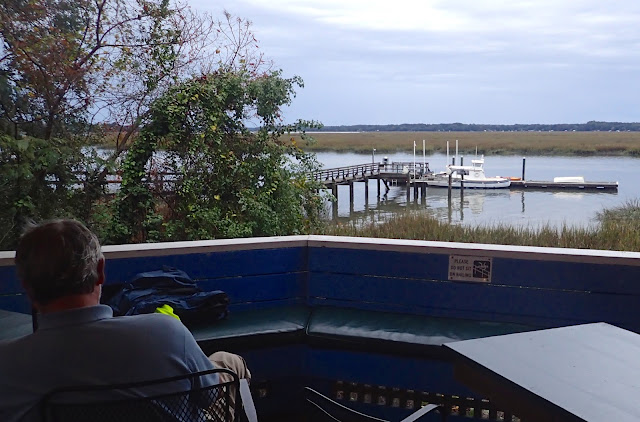posted by Ardys
 |
| Bridge in Daytona Beach |
Okay, these aren’t really secrets, per se, but before starting down the ICW (Intracoastal Waterway) I didn’t hear about them. Only one person in Annapolis told us that the ICW was a very special place and that it would be well worth staying inside to go south. “Inside” refers to the ICW, inside the barrier islands which separate the mainland from the ocean. “Outside” of course, means out on the ocean. Outside can be faster if the weather is good for crossings. The weather rarely was right for us when we were at a convenient inlet to exit the ICW, and so we continued on. Maybe on a future trip south, we’ll bring additional crew with us and go on the outside ALL the way to the Caribbean. On this journey south, however, we’ve only gone outside twice, on overnight ocean passages of 70 to 80 miles each.
 |
| Surprising find--free dock available |
We are nearing the end of our journey for 2015. Tomorrow we will arrive in Titusville, across from Cape Canaveral, on Day #34 of the ICW. We will leave our boat there for a month while we visit family and friends over the holidays. Covering only 30 to 50 miles/day usually and resting for a day or two here and there, has made this a long trip. I wouldn’t have wanted to do it any faster, at least not on the ICW. I want to tell people why I will NEVER again refer to the ICW as the “Ditch.”
 |
| Sunset north of Cumberland Island |
Fabulous sunrises and sunsets at quiet anchorages. Not every single day (we did have rain a few times) but there are few sights as utterly dramatic and yet unique as the rise and fall of the sun. Quiet descends upon the anchorage and we hear the sounds of the water and whatever critters are out and about calling to each other, or feeding, or whatever they do in the dark. With a moon shining on the water, we can see surprisingly well, even after full night.
 |
| Fernandina Beach dressed for Christmas |
 |
| Best margarita EVER at Pablo's |
Marinas that provide a great value for the money. There are marinas that are absolutely beautiful with long, wide docks, resort-like qualities such as pools, fitness centers, much like you’d find at a 4 star hotel. As you might imagine, the “resort marina” is the most expensive way to go down the ICW. All marinas charge by the foot (boat length) so with our 43’ boat, this adds expense quickly. We stay at a marina occasionally, when we need to get groceries, do laundry and get a pump-out. On the opposite end of the marina spectrum are marinas which have old docks and few, if any amenities. Perhaps you’d compare that sort of marina to a budget motel. Most marinas fall somewhere in between the resort and the budget marina and generally, you get what you pay for. We found our favorite marina ever yesterday at Marineland Marina north of St. Augustine. Relatively inexpensive, very attractive, wonderfully helpful dock staff, dog friendly, and located a very short walk from the ocean. We will definitely return there.
 |
| Jax enjoyed the beach |
The ICW has made me into a birder! We brought a bird book with us onto the boat and a pair of birding* binoculars but I thought we would only occasionally use them. Hah! I can now identify at least 20 new birds, even in flight. I can distinguish between dabbling and diving ducks although I haven’t had as much luck with nailing specific species. I was already familiar with the cormorants, eagles and loons because we have those in Minnesota. I started studying the huge pelicans and then thought that I may as well learn how to identify several egrets and herons too. One thing led to another and now I’m hooked. The ICW is a virtual parade of birds all day long!
 |
| Beach at Marineland |
In fact, going south on the inside is a lot like a parade: waterfront historic towns and cities, luxurious homes and folksy little houses in the wilderness, plants and trees, beautiful bridges and other unique structures, not to mention all the other boats. I can’t wait to tell the man who told us the ICW would be special, how right he was.
 |
| Great Egret - note: yellow beak, black legs |
*We carry two pair of 7 X 50 marine binoculars with internal compasses. A stronger magnification would be too unstable for a moving vessel. Birding binoculars can be much more powerful.




















